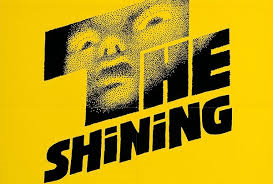
In any comprehensive comparison between novels and their film adaptations, the deck is so stacked in favor of “the book was better,” that the exceptions (Jaws, The Godfather, Fight Club, Children of Men, arguably a dozen or so more out of the thousands of adaptations ever made) only end up proving the rule. The list of terrible films made from good books is far too long to list.
Even rarer, though, are the “split decisions,” where both the source and the adaptation have passionate defenders. I can’t think of another case where the two camps are so divided, and equally vocal, as in the case of The Shining.
The Shining was Stephen King’s third novel (following Carrie and ‘Salem’s Lot,) first published in 1977. It was the first King novel I ever read, at a ridiculously inappropriate and impressionable age. In my opinion, it remains his best work; a near-perfect balance of supernatural horror and heartbreaking human tragedy.
The movie version was directed by Stanley Kubrick, one of the most groundbreaking and influential directors in the history of cinema. His version of The Shining is hypnotically beautiful, pulsing with menace, visionary and terrifying- widely regarded as one of the greatest horror films ever made.
Though they tell essentially the same story, the book and the movie are radically different- at points they are diametrically opposed. Remember the Robert Frost poem that started with the line “Some say the world will end in fire/ Some say in ice”? That almost perfectly describes the contrast between the dueling S.K.’s.
King is fire. A warm, humanistic storyteller with a workman’s style, who realized early in his career that the secret to making the most fantastic and horrific situations believable is to ground them with realistic, sympathetic characters.
Kubrick, by contrast, was ice. A cold aesthetician and a fastidious stylist, who achieved his horrific effects via his masterful grasp of how the human mind processes motion picture images and sound. Some of the images he conjured in The Shining- an elevator shaft overflowing with blood in hypnotic slow motion- the young boy hurtling down endless hallways in his Big Wheel and coming face-to-face with twin ghosts- are indelible and iconic. He utilized meticulous frame composition and editing tricks to induce an unsettling spatial disorientation. Characters were of secondary importance to him, though. (As also evidenced in his masterpiece 2001: A Space Odyssey, in which the human astronauts were interchangeable blanks, and the most compelling character was a murderous, red-eyed computer.)
The comparison is made literal, too, in the endings. King ends his Shining with fire, and Kubrick ends his with ice.
So, which is better? There is more than a little controversy surrounding that question, and my answer might strike some as a hedging cop-out:
I choose BOTH.
I love the novel and I love the film. My dream is to mash the two together into an ultimate, definitive edition that culls the best from each. Merging King’s empathy with Kubrick’s merciless mind-fuckery; combining both men’s divergent visions without dulling the edge of either. Creating the Best of Both Shinings (or BoBS) version can be accomplished, I think, in seven easy steps:
1) Invent a time machine.
2) Travel back to 1970 or so.
3) Use my knowledge of seventies cinematic trends to become the most powerful film producer in Hollywood. (I’ll take risky chances on young upstarts like Coppola, Lucas and Spielberg.)
4) Buy the rights to up-and-coming author Stephen King’s third novel before it’s even published.
5) Adapt the screenplay myself.
6) Hire Stanley Kubrick to direct.
7) Force Kubrick to stick to my script and give me final cut of the film. (NOTE: I understand that the invention of time travel will be easy-peasy compared to wresting artistic control from Stanley Kubrick.)
I should acknowledge that there was a previous attempt to “fix” The Shining, in a 1997 TV mini-series written and produced by King himself- who famously hated what Kubrick did to his novel. The less said about this the better. Marred by bad acting (lead Steven Weber is as bland as white bread toast,) chintzy special effects (behold the terror of CGI hedge animals,) and a flat, over-lit, shot-to-tape production that trades the film’s visual genius for the look of your average daytime soap. To say that director Mick Garris is no Stanley Kubrick commits the unpardonable crime of including both their names in the same sentence. Worst of all, King’s script is dull and pedestrian, with far too much expository dialogue. Let’s never speak of it again.

JACK TORRANCE
Stephen King’s biggest complaint with Kubrick’s film is in the handling of the lead character. In the novel, King gave doomed father Jack Torrance a tragic character arc. Jack Torrance struggles with both his alcoholism (mirroring King’s own addictions) and his uncontrolled anger. He is brought to the haunted Overlook Hotel by financial desperation. Having lost a teaching job at a prep school after beating up a student, he utilizes the connections of a reformed drinking buddy to get the caretaking job. Chastened and humiliated by his new position, he nevertheless views the job as a clean start. A chance to reconnect with his wife and son, and to reinvigorate his writing. He is haunted by his past- in particular a harrowing incident in which he accidentally broke his son’s arm while drunk- but at the start of the novel is genuinely striving for redemption. This makes it ultimately heartrending when the Overlook plies him with ghost booze and pushes him over the edge into murderous violence.
The film, though, has no empathy for poor Jack Torrance. There’s no arc. He’s crazy from the get-go. Jack Nicholson plays the early scenes as either blank or grouchy, and Stephen King asserts to this day that this was an egregious case of miscasting. Yeah, maybe, except. . .
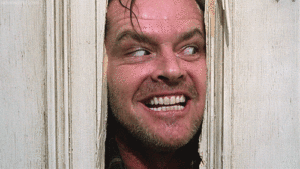
In the last half of the film, Jack Nicholson delivers the most terrifying depiction of axe-crazy batshittery ever committed to film. He contorts his face and body into a mask of unrefined insanity in a performance so over-the-top that Kubrick himself likened it to Kabuki. (Kubruki?) Even before his rampage, Nicholson is brilliant in a scene where delivers a monologue at the bar that descends into a dialogue when the ghostly bartender appears. Jack is crazed enough at this point to just roll with it, as long as the guy’s pouring. Also, his delivery of: “Wendy? Darling? Light of my life. I’m not gonna hurt ya . . . I’m just going to bash your brains in! Gonna bash ’em right the fuck in!” has to be heard to be believed.
BoBS VERSION: Why can’t we have it both ways? Jack Nicholson is capable of delivering nuanced performances. Look at Five Easy Pieces, As Good as It Gets, or About Schmidt. The zero-to-“Here’s Johnny!” business was a directorial decision on Kubrick’s part. Re-write the script to give the character more (or any) interaction with his wife and son at the start of the movie, establishing that he genuinely loves his family. Delve into his back story a little. Tell Jack to reign it in at the beginning. That way, when you let him off the leash and let him go full-tilt Kubruki at the end, it will have both an emotional and a visceral impact.
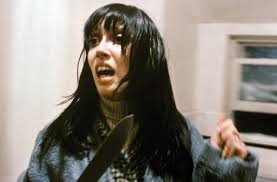
WENDY TORRANCE
King was also supremely dissatisfied with the film’s treatment of this character, saying: “Shelley Duvall as Wendy is really one of the most misogynistic characters ever put on film,” and that she’s “presented as a screaming dishrag.” He has a valid point. The character is an annoying nag at the beginning and a hysterical victim at the end. Also, I know it’s not right to criticize an actress for her physical appearance, but Duvall looks terrible in this film. The blame for this is squarely on Kubrick, though. The unflattering hair, make-up and costume choices were deliberate directorial decisions. Even worse, he elicited Duvall’s harrowed performance by berating her so severely that it verged on psychological abuse. (Watch the behind-the-scenes doc directed by Kubrick’s daughter Vivian, included on many DVD editions. It’s painful. Kubrick taunts his actress with an utter lack of sympathy, until she breaks down in tears and actually pulls out clumps of her hair.)
I suspect that Kubrick’s strategy in making Wendy so annoying was to put the audience into the headspace of the murderous Jack. He wants us to see her as Jack does, and wants us to want to see her punished.
That’s messed up.
Wendy in the book is much better, though there is still room for improvement. King obviously treats the character with more empathy than Kubrick did, but as a male author in the seventies, he tends to only position her in relation to her husband and her son. She’s a concerned wife and a fiercely protective mother, but is not granted the kind of vivid internal life that the two male characters have.
BoBS VERSION: First and foremost, recast. Diane Keaton was at the peak of her career in 1980, and Meryl Streep was hot off of winning an Oscar for Kramer vs. Kramer. Either of them would have made a great Wendy, both actresses capable of going toe-to-toe with Nicholson. (And, hopefully, with Kubrick.) And both of them could have given the character shades of nuance lacking in either existing version. Both Shinings present an essential “Jack vs the Overlook vs Danny” conflict, so the Wendy part would need to be beefed up in any ideal version.

DANNY TORRANCE
I lean a bit more towards the movie Danny. Almost half the novel is from Danny’s POV, and he comes across as a bit more precocious than even an exceptionally bright (and psychic) five-year-old would be in real life. By not having to present his internal voice, the film relies on the remarkable child actor performance Kubrick coaxed from Danny Lloyd. Reportedly unaware that he was even making a horror film at the time, young Danny is never less than convincing. Curiously exploring the Overlook on his Big Wheel, waggling his finger while talking to “the little boy who lives in my mouth,” croaking “Redrum! Redrum!” and running from his father in the snowy hedge maze. The kid sells it.
According to imdb, Danny Lloyd only has one other film credit (playing a young G. Gordon Liddy in a TV movie!) and is now a Biology professor at a Kentucky community college. He was one child actor who knew when to quit.
BoBS VERSION: Leave well enough alone. Keep the Danny Lloyd performance pretty much as is.
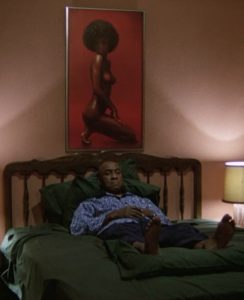
DICK HALLORAN
As in the case of the Wendy character, the Overlook’s resident psychic chef is not perfect in either version. Stephen King’s fondness for the “magical negro” trope has been well documented (see also The Stand, The Green Mile and The Talisman, among others) but at least he lets Halloran live in the book. (And heroically save Danny and Wendy’s lives in the end.) In the movie, the only on-screen homicide is the one black character traveling thousands of miles to save the white family, only to get an axe to the chest.
That being said, Scatman Crothers is perfect in the part. Watch the scene in the kitchen when he explains “shining” to Danny. That’s a tricky scene to pull off opposite a child actor, and Crothers nails it. Plus, he has amazing taste in art.
BoBS VERSION: Keep the Scatman, but let him live at the end.

JACK’S BIG WRITING PROJECT
I’d be willing to bet that the one moment in the movie that made King wish he’d thought of it first is when Wendy, curious as to what her husband’s been working on all this time, looks over his work-in-progress only to find the phrase “All work and no play makes Jack a dull boy” typed thousands of times, on reams of paper. It’s the most famous (and oft-parodied) scene in the movie. (“No beer and no TV makes Homer a homicidal maniac.”)
BoBS VERSION: Keep that bit, obviously. But if King had included it in the book, he probably would have built it up more. One recurring element in his novels are obsessive phrases that creep into a character’s consciousness to portray the unravelling of their sanity. Maybe the phrase is uttered as a line of dialogue in the play Jack is writing, but sticks in his head for some reason. We should establish at the beginning that Jack actually is a writer, but as madness consumes him, he becomes incapable of expressing anything except that single mantra.
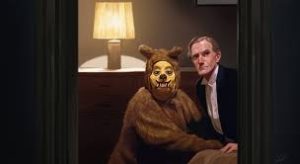
WHATEVER THE HELL THIS IS
This is actually well-explained in a dream/ flashback section of the novel. One of the Overlook’s owners, the gangster Horace Derwent, was a notoriously perverse bisexual. (My favorite kind.) A former male lover of his is disappointed that Derwent hardly ever “goes back for seconds” when it comes to men, but is told that if he comes to a costume ball dressed as a “cute doggy,” Derwent might reconsider. Stephen King presciently foresaw the “furry” movement decades ago. He may have even invented it.
I think it works better in the film, though, where the startling image pops up without any context or explanation. It’s a real “What the fuck is THAT?!?” moment. The symbolic importance of Kubrick changing the costume from a dog to a bear is just one of many aspects of the film exhaustively analyzed on the internet, if you care to search for it.
BoBS VERSION: Don’t change a thing, or else risk depriving the future internet of many entertaining memes.
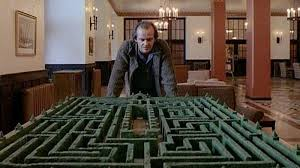
TOPIARY ANIMALS VS. HEDGE MAZE
The Overlook’s landscaping played a major role in both book and film, though in different ways. In the novel, Danny is playing alone in the Overlook’s snow-covered playground when he’s menaced by ornamental shrubs trimmed into the shapes of various animals. They never move when you look at them, but as soon as you turn away . . .
That scene was very effective in the novel, relying upon the reader’s imagination to conjure the images. When presented in a visual medium, though, it just looks silly. The TV movie proved, perhaps definitively, that shrubbery just isn’t that frightening.
BoBS VERSION: Close your eyes and picture Jack Nicholson pursuing his son through the dark, snowy labyrinth. See that clearly? That’s because it’s a potent, surreal image. Definitely keep the hedge maze.
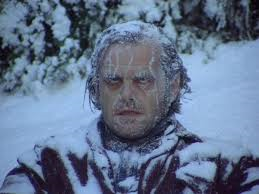
THE ENDING
With most sincere apologies to Stephen King, I’m solidly in the Kubrick camp for the ending.
In the book, the Overlook is destroyed when the boiler explodes. Jack, head full of ghost booze and intent on murdering his family, forgot that one of his key duties as winter caretaker was to dump the pressure on the boiler, which lacked a safety valve. This device is problematic for several reasons. From a narrative standpoint, the “creeping” boiler is a gaping Chekov’s gun that becomes a Deus ex Machina in the end. It’s also wildly implausible. Wouldn’t the Overlook’s insurance inspectors (who were scrupulous enough to insist upon removing all the alcohol) demand that the hotel get rid of the self-destruct mechanism in its basement? Especially given the place’s history with winter caretakers who tend to shirk their duties and go axe-crazy?
The ending of the movie is brilliant, though. Jack gets lost in the maze. Exhausted, he sits down and freezes to death. Then there’s that amazing, enigmatic closing shot of the photograph from the twenties, Jack Nicholson grinning in the center of a group of party-goers. The Overlook has absorbed Jack into its coils. He’s always been the caretaker.
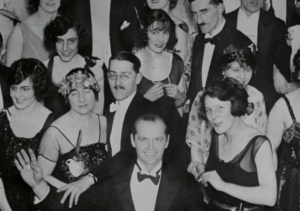
BoBS VERSION: Keep the chilled perfection of the movie ending, but import one bit from the novel. Towards the end of the book, Jack actually catches up with Danny (chasing him through the hotel hallways rather than the hedge-maze.) He’s about to murder his son, but then Danny takes his hand and manages to speak to the last remaining vestige of his beloved Daddy. For just a moment, Jack is Jack again. Then the part of Jack that’s consumed by the Overlook obliterates what’s left of the man by smashing his face off with the mallet he’s carrying. Occupied by this, Jack allows Danny to go free. This final act of redemption is heartbreaking, and could be easily imported into the film. I think it would strengthen the ending. Plus, how much more jarring would that image of the Jack-sicle be if half his face was chopped off with the axe?
So, in simplest terms: take the first half of the book, and the last half of the movie. Swap out Shelley Duvall for Meryl Streep and let Scatman live. There you have it. The Best of Both Shinings. Now if you’ll excuse me, I’m going to get started on the Kickstarter campaign to get that time machine built.
FURTHER READING/ VIEWING:
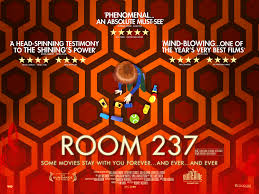
If you think I’m overthinking The Shining, you should really check out ROOM 237, a fascinating documentary (currently available on Netflix) in which obsessive viewers lay out their cases that The Shining is really about Native American genocide, or is Kubrick’s coded confession that he helped NASA fake the moon landing- among other theories with varying degrees of plausibility. Kubrick’s densely layered vision is complex enough to allow for many interpretations. The film also contains excerpts of THE SHINING FORWARDS AND BACKWARDS, which superimposes a forward and a reverse screening of the film, turning it into a mind-fuck palindrome. Kubrick’s obsessions with symmetry really pay off here, as the overlaid images allow for some startling juxtapositions. It’s a far wilder cinematic head-trip than synching The Wizard of Oz with Dark Side of the Moon.
 There’s also DOCTOR SLEEP, King’s belated sequel to his original novel. Personally, I was deeply disappointed by this. It had a promising set-up, with the adult Danny Torrance coping with his father’s inherited legacy of alcoholism and rage- and using his “shining” abilities to assist hospice patients in “crossing over.” But then it descends into a somewhat silly story about a cult of vampire RV-ers (or something) with some of the clumsiest plotting the King has ever put to paper.
There’s also DOCTOR SLEEP, King’s belated sequel to his original novel. Personally, I was deeply disappointed by this. It had a promising set-up, with the adult Danny Torrance coping with his father’s inherited legacy of alcoholism and rage- and using his “shining” abilities to assist hospice patients in “crossing over.” But then it descends into a somewhat silly story about a cult of vampire RV-ers (or something) with some of the clumsiest plotting the King has ever put to paper.

